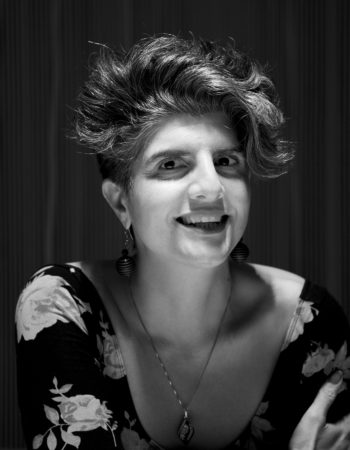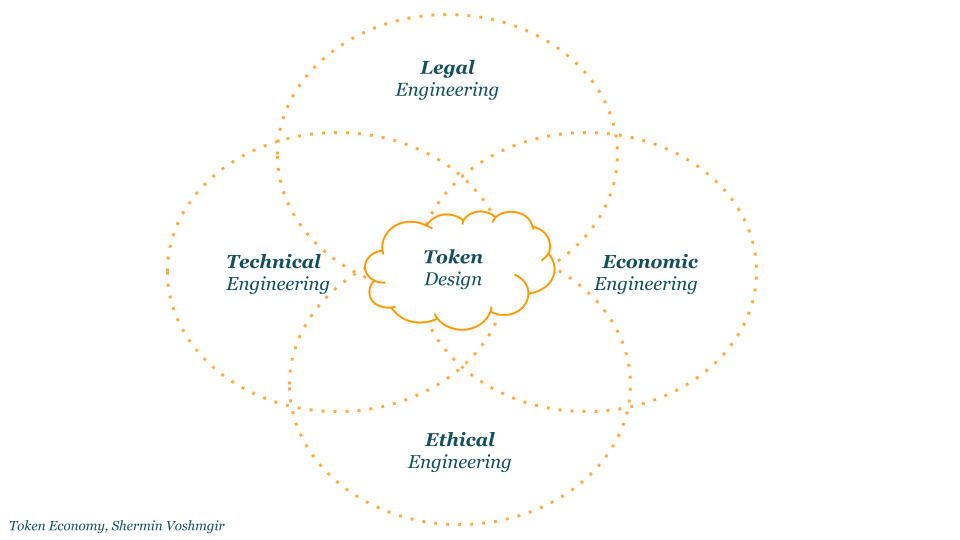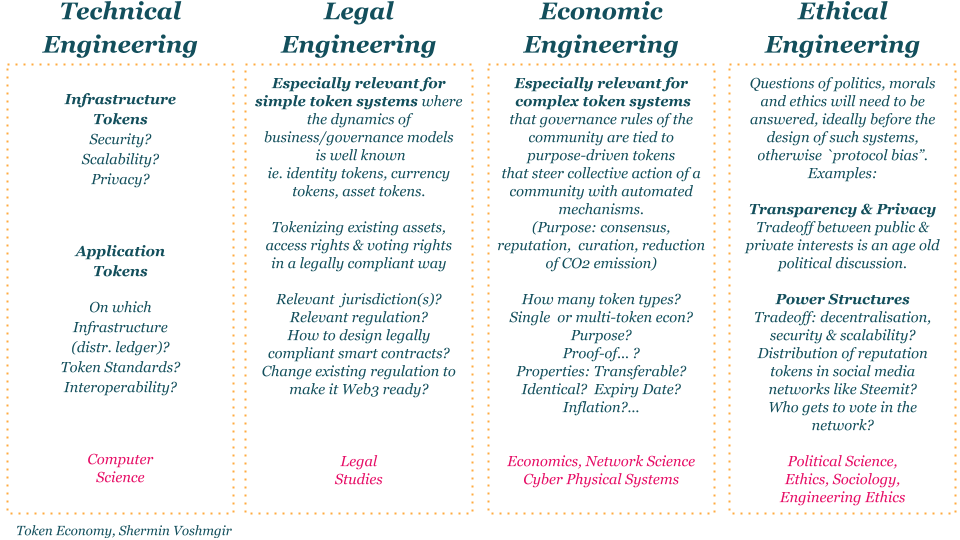
Shermin Voshmgir is the author of the book Token Economy, the founder of Token Kitchen and BlockchainHub Berlin. In the past she was the director of the Research Institute for Cryptoeconomics at the Vienna University of Economics which she also co-founded. She was a curator of TheDAO (Decentralized Investment Fund), an advisor to Jolocom (Web3 Identity), Wunder (Tokenized Art) and the Estonian E-residency program. In this podcast we discuss “How to design your own token system”.
What is blockchain?
Blockchain is a collectively maintained public infrastructure where people are incentivised to keep the ledger up to date in a trustful manner. It is the backbone of this new generation internet often referred to as the Web 3.
Blockchain allows its participants to collectively settle data transactions, whether its value transactions or data flows on a shared public infrastructure that everyone can trust. This contrasts to today’s Web 2 which is managed by private client server infrastructure where data is managed and stored behind the walled gardens of a server that belongs to a specific institution or a private entity.
Shermin believes that blockchain itself isn’t particularly interesting. What is interesting is that blockchain brought the back-end revolution for a decentralised web or Web 3. Tokens are the killer application of the Web 3 as websites were the killer application of the early internet in the 1990s when the World Wide Web came about.
Types of tokens
Cryptocurrencies and crypto assets are specific type of tokens.
A token can represent money, whether it’s state issued money, often referred to as CBDC (central bank digital currency) or virtual currencies such as cryptocurrencies.
Tokens can represent any type of assets such as commodities, physical assets and fungible assets like art or real estate. Any virtual or real asset can be tokenized and have a digital representative that is easily traded.
Tokens can also be used to represent an identity of a person, machine or an institution. Credential tokens are tokens that are tied to an identity or that have limited transfer abilities.
Token System
A system is use to described how people and objects interact in this physical world. Token systems can have varying degrees of complexity.
Usually, the more actors are involved in a system, the more complex the system and its interactive parts become.
An example of a complex token system is the Bitcoin network which is a network of physical computers operated by humans or institutions. It has a three-layered network composed of tokens, machines, and peer-to-peer network.
An example of a less complex system is a token system that represents tokenizing shares in a company which can be settled on a public or semi-public infrastructure.
Creating a token system, the questions
When creating a token system the main questions that one should ask themselves are:
- What do you want to do?
- What is the purpose of your venture?
For example, if you want to tokenize real estate, the question of how to design your token system is very different than if you want to create a token based social network where the token creation needs an intelligent incentive design for how to incentivize people to upload and curate posts. An example of such a token system is Steem. However, such token systems are very complex and have a lot of unanswered questions.
Tokenising real estate whilst it involves a series of complex legal questions sits within an understood legal framework. Whilst they may seem less complex they can very easily become more complex where your individual real estate objects can be tokenised allowing for fractional tokenization of a single object, like an apartment.
There is a series of technical, legal, economic and ethical questions to be asked when we design our token system, but the first question is always, what do I want to do?
Design thinking and engineering design for token systems
Design thinking became popular in the startup world in the 90s. It helps to strategically plan concepts for any new technology, products or service. The process ranges from problem definition, ideation, solution-focused strategies, modelling, prototyping, testing and evaluating including iterative feedback loops thereof.
In the case of token systems, design thinking approaches, the technology being blockchain allows for interactions to happen on a socio economic level. It also allows for the move away from individual products and services to collectively shared dynamic socio economic systems.
In March 2018, Trent McConaghy, co-founder of Ocean Protocol, coined the terms token engineering and explained his thinking in a blog post entitled “Towards a Practice of Token Engineering”. Which he describes as: “the theory, practice and tools to analyze, design, and verify tokenized ecosystems.“
Trent also defined “Engineering is about rigorous analysis, design, and verification of systems; all assisted by tools that reconcile theory with practice. Engineering is also a discipline of responsibility: being ethically and professionally accountable to the machines that you build”.
For Shermin, engineering always requires the ethical part. Part of the challenges of the early websites is that the engineering ethics of building websites didn’t exist. When websites failed they simply pivoted. Token engineering forces us to think in more robust and responsible ways and it can sit at the intersection of design thinking when creating new token systems.
Technical engineering.
Token systems either have an infrastructure token or an application token.
Infrastructure token are tokens that steer blockchain networks. Bitcoin is an infrastructure token which is used to incentivize participants in the network to contribute to the security of the network. Similarly, Ether is the infrastructure token on the Ethereum network. Infrastructure tokens are used in Web 3 networks that have a native currency to incentivize network behaviour and contribution.
When designing an infrastructure token you have to balance the needs for security, scalability and privacy.
Application tokens on the Ethereum network allow the creation of simple smart contracts on an application level. These application tokens can represent a myriad of different applications such as an asset back currency, a piece of art, fractional ownership of a real estate, a reputation token on a social network and a number of other applications.
When designing an application token you have to balance the needs for infrastructure, interoperability and standards.
Legal engineering
We’ve had securities for hundreds of years. As a society we know how to issue securities, manage securities and manage the issue of fraud and security. Essentially, we have built the mechanisms to prevent fraud, to protect investors and to create a safe ecosystem where we avoid the kind of stock market crash we had in the 1930s.
If we were to tokenising the New York Stock Exchange for example we would need to answer the following questions:
- How to do it in a legally compliant manner?
- Are new laws or a regulatory environment required to encompass the use of a new technology solution?
Legal engineering, whilst is complex in itself, is only focused on the legal aspect. Tokenisation of existing businesses, networks and institutions predominantly requires legal engineers, which refers to making the tokenization of existing assets, access rights and voting rights legally compliant within relevant local legislation. In this case legal engineering refers to the tokenisation of traditional governance models where smart contracts replace many of the existing human, paper and client server based operations.
Economic engineering
Economic engineering is used when designing “complex token systems”. What contributes to the complexity of a token system is:
- how big is the network. The higher the number of individual or autonomous actors are in the network the higher the level of complexity.
- Number of interactions
- Number of types of tokens you have in a token economy, such as a multi-token economy
Tokens are there to they steer collective action towards a common purpose. The main question that need to be answered in such design process are:
- Goal of the token system
- Number of different types of tokens – single vs multi-token economy
- Purpose of the token
- Properties of the token including their transferability and fungibility
The economic engineering aspect of creating decentralised autonomous organisations where you have a number of autonomous actors from different backgrounds you need to have behavioural economics, ecological economics, micro and macro economics. You need network scientists and people of different skill sets.
Ethical engineering
In building effective token systems, you need people with an economics background, network science background, cyber and physical systems background for the economics part, but in the end, these token systems, are about the socio-economic coexistence of people in social network which has many ethical questions.
- The question of transparency versus privacy. There is a trade-off between what should be public and what should be private
- Power structures. If a token system incentivize network actors with a network token, it needs to ensure that it doesn’t favour a set of network actors over others









